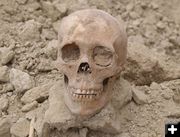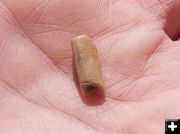

Skull
Complete adult skull found while crews were digging a septic field near Pinedale. This was one of six skeletons found at the site, believed to be Native American from approximately 1,000 years old. Photo by Dave Vlcek, Bonneville Archaeology.
|


Bone Bead
Artifact found at the site. Photo by Dave Vlcek, Bonneville Archaeology.
|
|
Archaeology talk in Pinedale Oct. 15
Dr. Rick Weathermon will give an update on six 1000-year-old skeletons found near Pinedale in 2007
October 12, 2019
The Upper Green River Basin Chapter of the Wyoming Archeology Society will be having a meeting on Tuesday, October 15th, at 6:30 pm at the Museum of the Mountain Man in Pinedale. There will be a short business meeting followed by a presentation by Rick Weathermon. Everyone is welcome. Please invite your friends.
PRESENTATION: "Violent Confrontations in Western Wyoming during the Late Prehistoric Period" by Rick Weathermon, University of Wyoming
In 2007, six approximately 1000-year-old skeletons were found on the Morrell property one mile west of Pinedale while digging a leech field. Previous research indicates two female adults, one male adult, and three children from 6 years old to infant. Rick has done extensive new research on those remains which will be part of this presentation. For more background see Human Skeletons Found Near Pinedale, Ancient Human Remains Found, and An Update on Bones Found Near Pinedale.
Violent confrontations between individuals and groups are apparent during the early Late Prehistoric period in the western Wyoming area. Multiple individuals documented in western Wyoming exhibit traumatic injuries, with a lack of defensive wounds on some suggesting capture and subsequent execution. Importantly, these individuals share a distinct cluster of skeletal characteristics. Similar conflicts are also evidenced during this same time among established horticultural groups in the American southwest along the southern and eastern edges of the Great Basin. Extended periods of drought likely placed stresses on human groups in and around these areas during the Medieval Warm Period, leading to population shifts. Changes in projectile point styles, ceramic technologies, and rock art in this same timeframe suggest that Numic groups were expanding into Wyoming, potentially replacing earlier Numic groups, or possibly Fremont culture related peoples. 48SU6440 (The Morrell Site) adds significant information to the interpretations of this violent period in Wyoming.
Rick L. Weathermon is a Senior Research Scientist at Department of Anthropology at the University of Wyoming. He received his B.A. with honors in Anthropology in 1990, M.A. in Anthropology in 1996, and Ph.D. in Anthropology 2011 from the University of Wyoming. Mr. Weathermon joined the Department of Anthropology as an Assistant Academic Professional Research Scientist in 1996. He serves as the Native American Graves Protection and Repatriation Act (NAGPRA) Contact, with half of his time devoted to Physical Anthropology and half to Archaeology. His primary activities consist of NAGPRA compliance, archaeological and human osteological laboratory instruction, and collections access and maintenance. Rick is focusing on perishable technologies. His research interests include bioarchaeology, historic and prehistoric use of the Black Hills of South Dakota and Wyoming, experimental archaeology, and bison ethology. In his spare time, he enjoys roaming the hills with his family, antique weaponry, and documenting sabretooth rodents of unusual size in Black Hills field camps.
MEMBERSHIP: Dues for 2020 membership are not due until January, but you are welcome to pay early. If you would like to be a member for 2020, please bring payment ($20/Individual, $25/Family) to a meeting, or print and mail the membership form (http://www.sublette.com/was/pdf/Membershipform.pdf) along with your dues. Membership dues help support WAS efforts at the state and local level including paying travel for speakers to come here to give great presentations.
|

